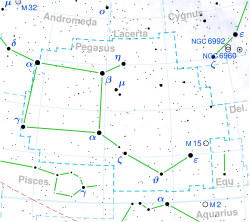Top Qs
Timeline
Chat
Perspective
51 Pegasi
Star in the constellation Pegasus From Wikipedia, the free encyclopedia
Remove ads
51 Pegasi (abbreviated 51 Peg), formally named Helvetios /hɛlˈviːʃiəs/,[12] is a Sun-like star located 50.6 light-years (15.5 parsecs) from Earth in the constellation of Pegasus. It was the first main-sequence star found to have an exoplanet (designated 51 Pegasi b, officially named Dimidium) orbiting it.[13]
Remove ads
Properties
Summarize
Perspective

The star's apparent magnitude is 5.49, making it visible with the naked eye under suitable viewing conditions.
51 Pegasi was listed as a standard star for the spectral type G2IV in the 1989 The Perkins catalog of revised MK types for the cooler stars. Historically, it was generally given a stellar classification of G5V,[14] and even in more modern catalogues it is usually listed as a main-sequence star.[15] The NStars project assign it a G2V spectral class.[4] It is generally considered to still be generating energy through the thermonuclear fusion of hydrogen at its core, but to be in a more evolved state than the Sun.[3] The effective temperature of the chromosphere is about 5,571 K (5,298 °C; 9,568 °F), giving 51 Pegasi the characteristic yellow hue of a G-type star.[16] It is estimated to be about 4.8 billion years old, about the same age as the Sun, with a radius 11.5% larger and 9% more mass.[7] The star has a higher proportion of elements other than hydrogen/helium compared to the Sun; a quantity astronomers term a star's metallicity. Stars with higher metallicity such as this are more likely to host giant planets.[17] In 1996, astronomers Baliunas, Sokoloff, and Soon measured a rotational period of 37 days for 51 Pegasi.[18]
Although the star was suspected of being variable during a 1981 study,[19] subsequent observation showed there was almost no chromospheric activity between 1977 and 1989. Further examination between 1994 and 2007 showed a similar low or flat level of activity. This, along with its relatively low X-ray emission, suggests that the star may be in a Maunder minimum period[14] during which a star produces a reduced number of star spots.
The star rotates at an inclination of 79+11
−30 degrees relative to Earth.[9]
Remove ads
Nomenclature
Summarize
Perspective
51 Pegasi is the Flamsteed designation. On its discovery, the star's planet — and actually the first exoplanet discovered around a main-sequence star — was designated 51 Pegasi b by its discoverers and unofficially dubbed Bellerophon, in keeping with the convention of naming planets after Greek and Roman mythological figures (Bellerophon was a figure from Greek mythology who rode the winged horse Pegasus).[20]
In July 2014, the International Astronomical Union launched NameExoWorlds, a process for giving proper names to certain exoplanets and their host stars.[21] The process involved public nomination and voting for the new names.[22] In December 2015, the IAU announced the names of Helvetios for this star and Dimidium for its planet.[23]
The names were those submitted by the Astronomische Gesellschaft Luzern, Switzerland. "Helvetios" is Latin for "the Helvetian" and refers to the Celtic tribe that lived in Switzerland during antiquity; 'Dimidium' is Latin for 'half', referring to the planet's mass of at least half the mass of Jupiter.[24]
In 2016, the IAU organized a Working Group on Star Names (WGSN)[25] to catalog and standardize proper names for stars. In its first bulletin of July 2016,[26] the WGSN explicitly recognized the names of exoplanets and their host stars approved by the Executive Committee Working Group Public Naming of Planets and Planetary Satellites, including the names of stars adopted during the 2015 NameExoWorlds campaign. This star is now so entered in the IAU Catalog of Star Names.[12]
Remove ads
Planetary system
Summarize
Perspective

On October 6, 1995, Swiss astronomers Michel Mayor and Didier Queloz announced the discovery of an exoplanet orbiting 51 Pegasi.[13] The discovery was made at Observatoire de Haute-Provence in France. On 8 October 2019, Mayor and Queloz shared the Nobel Prize in Physics for their discovery.[27]
51 Pegasi b (51 Peg b) was the first discovered exoplanet around a main-sequence star. It orbits very close to the star, experiences estimated temperatures around 1,200 °C (1,500 K; 2,200 °F) and has a mass at least half that of Jupiter. At the time of its discovery, this close distance was not compatible with theories of planet formation and resulted in discussions of planetary migration.[28] However, several hot Jupiters are now known to be oblique relative to the stellar axis.[29]
See also
|
|
References
External links
Wikiwand - on
Seamless Wikipedia browsing. On steroids.
Remove ads
